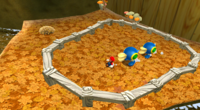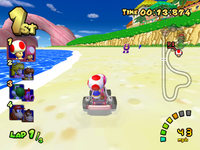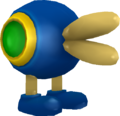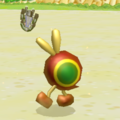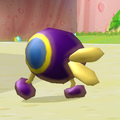Cataquack
It has been requested that this article be rewritten.
- “Those large-billed Cataquacks tend to be very territorial. So, when they spot an outsider such as yourself, they go wild! They'll run up and hurl you into the air, but they mean no harm.”
- —Noki, Super Mario Sunshine
Cataquacks, also called Paihanas[1], Piahanas[2] or Pihanas[3], are duck-like creatures that first appeared in Super Mario Sunshine on Gelato Beach. When they sense Mario nearby, they speed up and approach him. If they make contact, they will use their beaks to forcefully hurl Mario into the air. They can be both useful and dangerous; Mario can sustain damage if he lands on the same plane from which he was launched, but can reach platforms he otherwise could not with normal jumps. The blue Cataquacks are said to become nervous when confronted by strangers, but never want to harm them. However, a red variant called Chuhanas[4] or Red Cataquacks[5] will harm any strangers that are in their way. Their name may be based on the words catapult and quack, referring to their behavior and appearance (similar to a duck), respectively. Cataquacks, like Plungelos, resemble Wiggler segments, and are further connected by their similar location and Japanese names. Enemies with similar functions, called Heave-Hos, appear in Super Mario 64.
History
Super Mario series
Super Mario Sunshine
In Super Mario Sunshine, Cataquacks come in two colors: red and blue. The blue Cataquacks cannot damage Mario (unless he touches them directly), but the red ones can. According to an NPC in Gelato Beach, red Cataquacks are new to the area. The blue Cataquacks tend to be rather lazy and will fall asleep if left undisturbed while the red variants walk aimlessly. When provoked, Cataquacks will chase Mario until he gets far enough from them or they reach a ledge or water. By running into a Cataquack and getting thrown upwards, Mario can get high-floating coins. As the player progresses through Gelato Beach's episodes, the number of red Cataquacks and Cataquacks in general increases while the number of blue Cataquacks decreases. By Episode 8, only one blue Cataquack remains. Cataquacks can also appear in Sirena Beach during Episode 5. If King Boo spins three question marks on the slot machines, he may spit out two blue Cataquacks that will disappear after a short time. A sub-species of Cataquacks called Plungelos appear as mini-bosses in Episode 2 of Gelato Beach.
Normally, Cataquacks are immune to all of Mario's direct attacks, but when sprayed with F.L.U.D.D., they turn over and during that time, Mario can jump on them to get a coin. When turned over, they will be stunned but when jumped on, they will be stunned for a longer time. If Mario sprays them over sand they will naturally sink, eliminating the need for him to jump on them. However, they can only be truly defeated by Yoshi, being catapulted into the air by the outburst of a nearby Dune Bud, or luring them towards water while using the Hover Nozzle.[6] In Episode 8, Cataquacks swarm most of Gelato Beach, increasing the difficulty of bringing the watermelon to the Surf Cabana. When the watermelon hits a Cataquack, it is thrown upwards and destroyed, leaving a coin.
In the first episode, Mario can get a Blue Coin by overturning the single red Cataquack and jumping on it, and in the last episode, he can get a Blue Coin by doing so on the remaining blue Cataquack.
Blue Cataquacks are one on the few enemies in the game to be confirmed to be native, as most of the rest (including, presumably, the recently-introduced Red Cataquack) were created from Shadow Mario's graffiti.[7] Despite this, both types appear to splatter when they are defeated via a Dune Bud.
Super Mario Galaxy
In Super Mario Galaxy, Cataquacks make a reappearance. Mario uses them to fling him to high or out-of-reach places. Only the blue variety is present in this game, found in the Gold Leaf Galaxy and the Beach Bowl Galaxy. Honeybees are seen to keep them as pets, fencing them in. In this game, they can only be defeated by luring them into the water where they will vanish, but will reappear shortly after. If Mario spins the tail or ground pounds, they will be knocked out for a few seconds. Unlike in Super Mario Sunshine, Cataquacks are completely harmless in this game. Also unlike in Super Mario Sunshine, where Cataquacks immediately give chase when approached, these Cataquacks will jump and give out an excited squeak before chasing. They have a very slight redesign in that the yellow circles on their sides are now a defined ridge rather than simply a pattern, lessening the resemblance to Wiggler segments.
Mario Kart series
Mario Kart: Double Dash!!
In Mario Kart: Double Dash!!, Cataquacks are revealed to come in purple and green varieties, in addition to the red and blue colors. They can be found on Peach Beach. When a kart runs into them, the car is thrown upwards, stopping the driver and making them drop their items. The Cataquacks can be temporarily knocked out by Green and Red Shells, as well as Lightning.
Mario Kart Arcade GP / Mario Kart Arcade GP 2
In Mario Kart Arcade GP and Mario Kart Arcade GP 2, Red and Blue Cataquacks make a cameo appearence in the backgrounds of some courses in the Mario Cup.[8]
Mario Kart Wii
This course reappears in Mario Kart Wii with the Cataquacks. In that game, exclamation points appear above their heads when they become aware of any passing karts. They also behave a bit differently when karts come through the beach in the Wii version. In the original version, Cataquacks would not bother karts that were on the stone path along the edge of the beach. However, karts on the path can be attacked by Cataquacks in the Wii version. On Wi-Fi Connection and Time Trials, they do not give chase. More items like the POW Block, Mega Mushroom, Green Shell, Red Shell, and Bullet Bill can temporarily stun the Cataquacks.
List of appearances by date
| Title | Description | Original Release Date | System/Format |
|---|---|---|---|
| Super Mario Sunshine | Enemy | Japan: July 19, 2002 |
GameCube |
| Mario Kart Double Dash!! | Obstacle | Japan: November 7, 2003 |
GameCube |
| Super Mario Galaxy | Ally | Japan: November 1, 2007 |
Wii |
| Mario Kart Wii | Obstacle | Japan: April 10, 2008 |
Wii |
| Super Mario 3D All-Stars | Enemy (in Super Mario Sunshine), ally (in Super Mario Galaxy) | Japan: September 18, 2020 |
Switch |
Gallery
Icon for Peach Beach in Mario Kart: Double Dash!!
Data-rendered model from Super Mario Galaxy
A red Cataquack from Mario Kart Wii
Names in other languages
| Language | Name | Meaning | Notes |
|---|---|---|---|
| Japanese | ポイハナ[?] Poihana |
Poi is a colloquialism for throwing something away and hana means "nose" or "flower." Likely a combination of Heave-Ho and Wiggler's Japanese names. | |
| Chinese | 咻地[?] Xiū de |
Thrown | |
| German | Kataquax[?] | Similar to English name | |
| Italian | Catapapero[?] | From "catapulta" (catapult) and "papero" (duck) | |
| Korean | 날꽃[?] Nalkkeot |
? | |
| Spanish | Picocuac[?] | From "pico" (beak) and "cuac" (onomatopoeia for "quack") |
References
- ^ Bogenn, Tim, and Doug Walsh. Super Mario Sunshine BradyGames Official Strategy Guide. Page 6.
- ^ Bogenn, Tim, and Doug Walsh. Super Mario Sunshine BradyGames Official Strategy Guide. Page 103.
- ^ Hodgson, David S J, Bryan Stratton, and Stephen Stratton. Super Mario Sunshine Prima's Official Strategy Guide. Page 19.
- ^ Bogenn, Tim, and Doug Walsh. Super Mario Sunshine BradyGames Official Strategy Guide. Page 6.
- ^ Averill, Alan, and Jennifer Villarreal. The Super Mario Sunshine Player's Guide. Page 63.
- ^ Super Mario Sunshine - Killing every Cataquack in "The Watermelon Festival"
- ^ Template:Media link The title of the box is 「クッパJr.の落書き!」 which means The graffiti of Bowser Jr.! and the text says 「本作の敵キャラクターたちは、クッパJr.が落書きで生み出したという設定。そのため、水に弱かったり、デザインが他のシリーズと少々異なっていたりする。ヨッシーも、同様の理由で水に落ちると消えてしまう。」 which means This game's enemy characters are created by Bowser Jr.'s graffiti. That is why they are weak to water, and differ slightly in design from the rest of the series. Yoshi also vanishes if he falls in water for the same reason.
- ^ Let's Play: Mario Kart Arcade GP 2 (Longplay)

